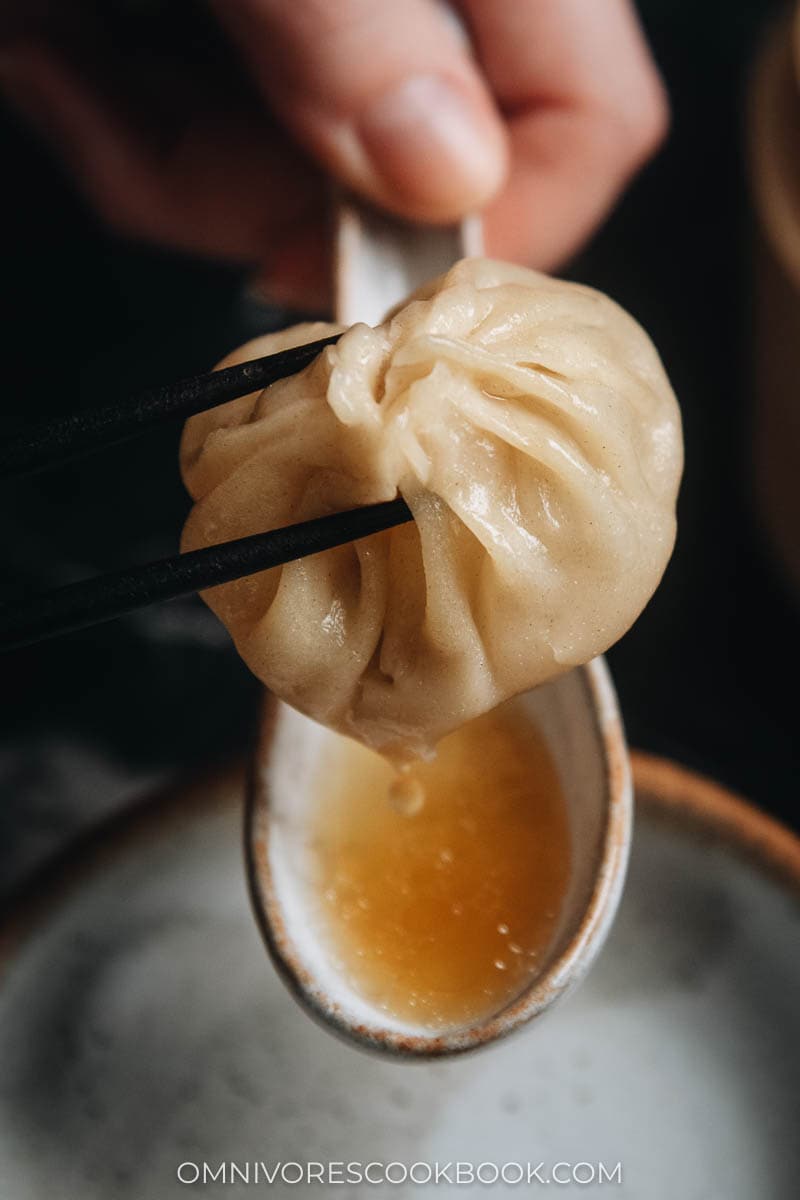
Soup dumplings are one of the most memorable dishes I ate during childhood. I grew up in Beijing in the 90s when restaurants from other regions were still scarce, and we rarely ate out. But there was this hole-in-the-wall Xiao Long Bao spot near my mom’s office that had the best soup dumplings. Once in a while, she would take me there to enjoy a steamer of piping hot soup dumplings as a treat. Their wrappers were literally paper thin, because you could see the juice inside through the semi-transparent dough. I took great care as I peeled them out of the steamer, careful to not break apart the dough and lose the soup. And when I successfully slurped up a mouthful of the fragrant soup, it was the greatest satisfaction for a 10-year old, one that lingers for 20 something years later.
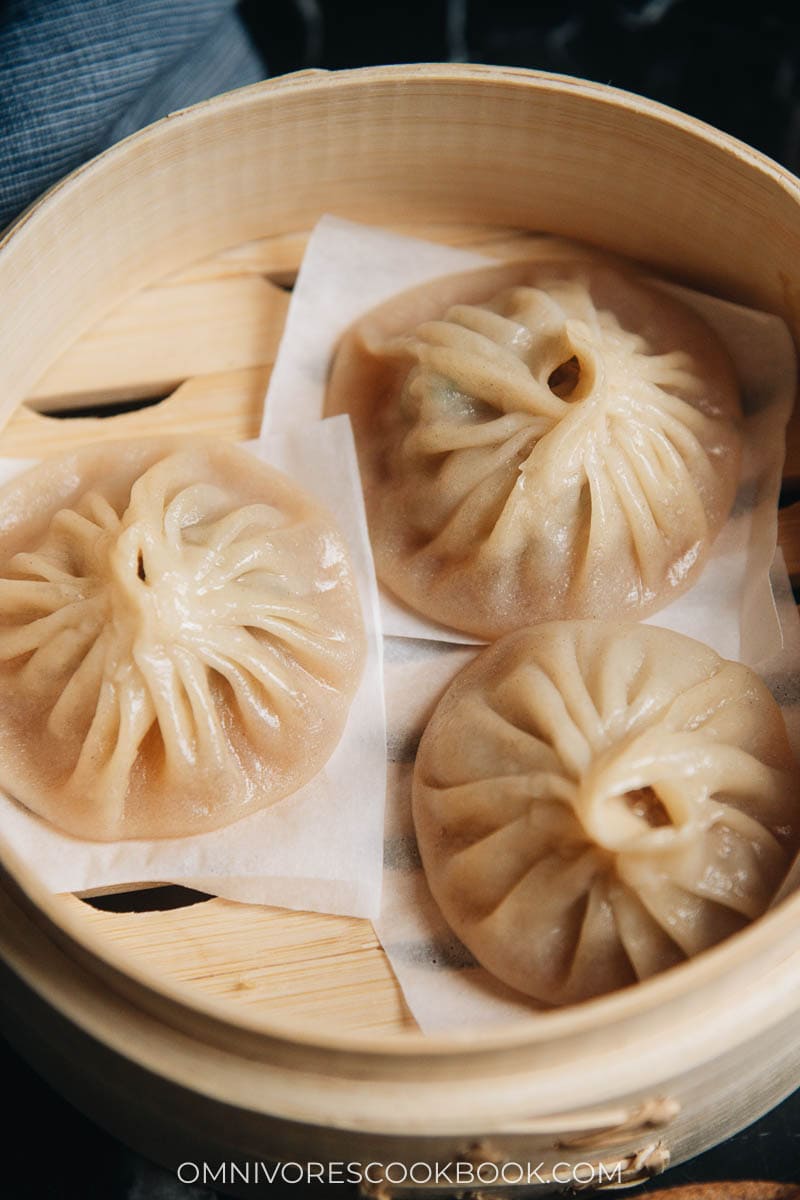
What are soup dumplings (Xiao Long Bao)
Xiao Long Bao (小笼包), or soup dumplings, are a type of steamed dumpling from Shanghai cuisine (Jiangsu province for the greater region). In China, you will find there are many versions of soup dumplings that come in different flavors and sizes, but the most popular one is Xiao Long Bao. It features a paper thin wrapper filled with a very mild pork filling and a pocket of fragrant soup, served with a gingery vinegar dipping sauce.
Xiao Long Bao is a type of dim sum that is traditionally enjoyed as a snack or during a meal as an appetizer or even a main dish. It’s certainly a complicated dish to make at home. But it’s such a great way to impress your guests if you’re hosting a dinner party.

How to put soup into the dumplings
To put soup into the dumplings, you will need to make aspic, or congealed meat broth. As you might have noticed, if you make chicken broth or pork broth at home, the soup will congeal into a gelatinous texture once chilled. Xiao Long Bao uses the same technique, only it makes the gelatin even thicker, so it forms a jelly-like texture that you can cut into small pieces that stay solid while you work them into dumplings. What you do is wrap the jelly into the dumpling along with the rest of the filling ingredients. Once cooked, the gelatin will melt down and become the soupy part of the filling.
Traditional approach
Traditionally, the meat gelatin is made with pork skin and/or trotters. Like making a pork broth, you simmer these ingredients for hours on the stove top, and then reduce the broth. The gelatin from the bones, skin and marrow will create a very rich tasting broth that will congeal once cooled.
However, since pork skin and trotters might not be found in a regular grocery store in the US, we looked for a different approach.
Our approach
Although I really love the scrumptious taste of soup dumplings, sometimes the filling can be quite heavy and greasy. That’s why I decided to look into creating a chicken broth to fill the dumplings instead of the traditional pork soup.
A while ago I talked about how to make chicken broth from leftover bones. This recipe uses a similar approach – using chicken backs and necks. And instead of braising, we developed an oven roasting method that helps you to get a very concentrated broth in less time.
The advantages of this method are:
- You can easily find the ingredients and they are very cheap to get.
- The method requires less cooking time.
- The result is more consistent, taking the guesswork out of how much you should reduce the broth.
- Because of the oven roasting method, you will get a super rich tasting soup just like you would with the pork version.
How to make soup dumplings
Prepare the jelly broth (aspic)
- Add chicken backs into a dutch oven or heavy pot
- Top with aromatics
- Roast covered until you get about 1/2 cup of chicken broth
- Chill in the fridge overnight until congealed, then scrape off the chicken fat from the top
- Slice the gelatin part, then dice it into small bits
- Once done, you can store the jelly in the fridge for 2 to 3 days until ready to use.
NOTE:
Depending on the type of pot you use and the quality of the chicken backs, the quantity of the broth can vary. I highly recommend weighing the gelatin and adding a bit of chicken fat if the quantity is not quite there.
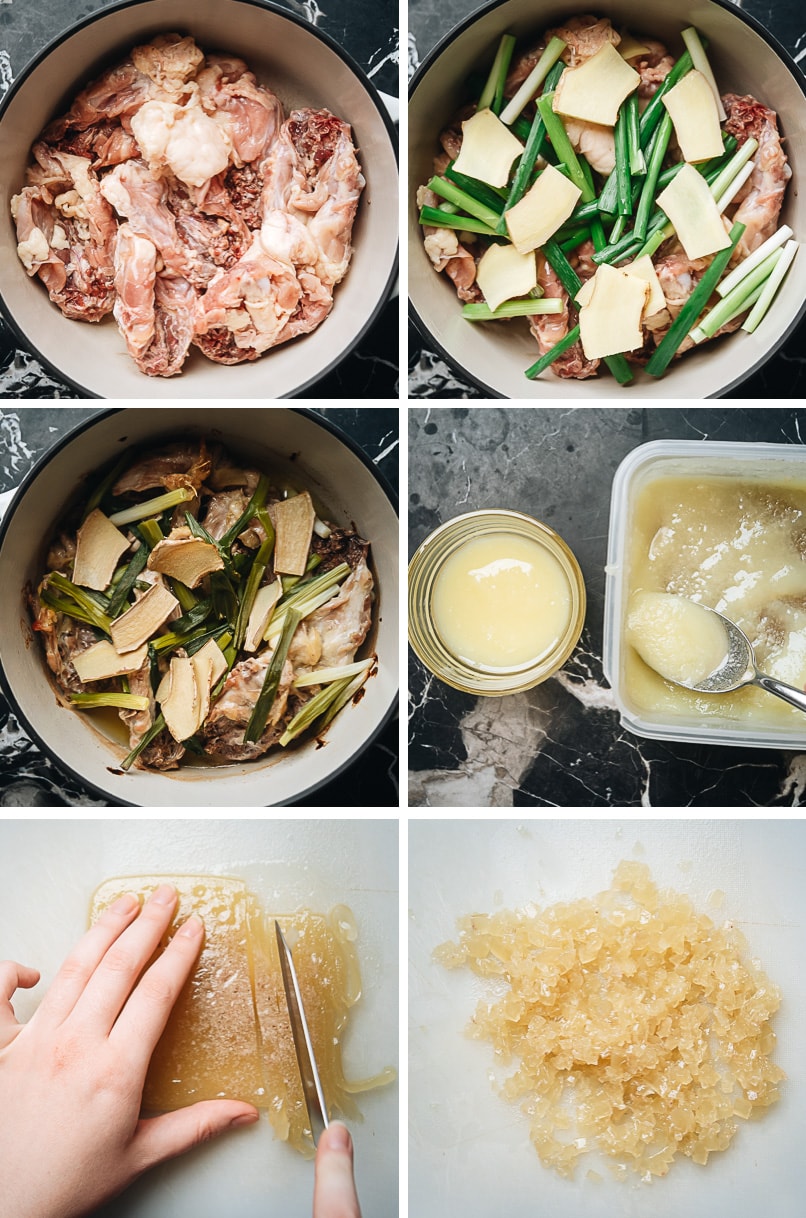
Prepare the filling
- Make a batch of ginger water
- Add the ginger water and the rest of the seasonings into the ground pork
- Beat until everything is fully absorbed and the meat becomes springy
- Add the chicken jelly and the green onion
- Mix well and store in the fridge until ready to use
COOKING TIP
Beating the ginger water into the pork helps to increase the moisture of the filling. You will need to spend some time mixing it, so the pork will become a bit bouncy. This helps the filling to bind together and make the wrapping easier.
For a more refined taste, you can strain and discard the ginger pieces and use just the ginger water. Personally I really love the gingery taste so I added the ginger bits into my soup dumplings.
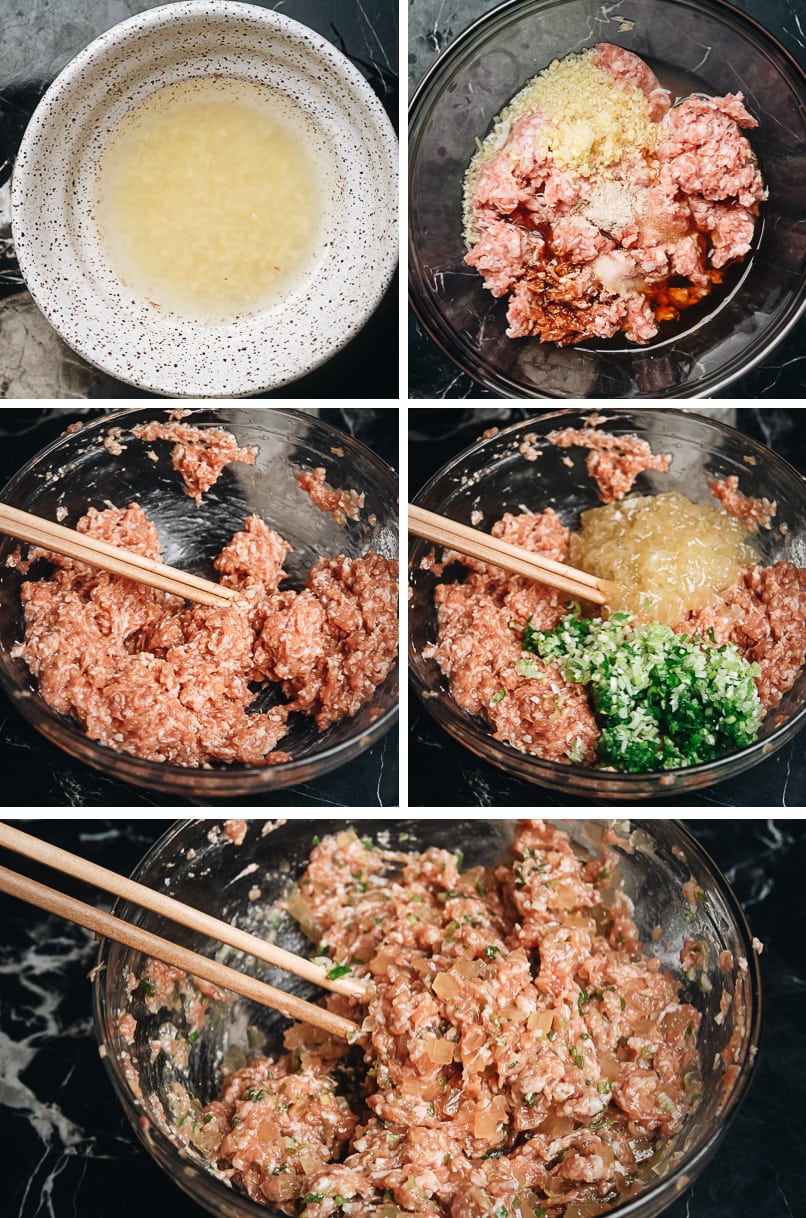
Assemble the soup dumplings
- Slowly drizzle water into the dough and mix. Hot water first, and cold water later.
- Knead with your hand until a dough is formed
- Keep kneading on the table until the dough becomes smooth
- Let rest until the dough become more smooth and the texture soft
- Roll the dough into a long log, cut into half and work on one piece at a time
- Cut the log into 10 even pieces
- Roll the dough into a very thin wrapper
- Add the filling
- Wrap the buns by making pleats
- Leave a small opening at the top so the steam will go out without bursting the buns
- Steam a few at a time
- Enjoy hot with the dipping sauce

Tips to success
Dough texture
Depending on the brand of flour you use, the humidity of your room, and many other factors, the flour will absorb water at a different rate. Even with all-purpose flour, the type you find in Asia is much lower in gluten (protein) than the one in the US. And within the US, I’ve found some flour brands such as King Arthur Flour have a slightly higher gluten content (11.7%). For this recipe, we tested using a regular all-purpose flour in the US, which is around 10% to 11% gluten.
When you make the dough, pay attention to the texture (you can view the video for more details). The dough should be soft but not sticky. Once rested, it would be quite pliable and easy to roll out.
The recipe below gives 5 grams of difference in the cold water. But based on your own environment, you might need to adjust it a bit further at the stage of adding cold water.
Ingredients measurement
Soup dumplings are a delicate dish that requires precise measurements to achieve the best result. I highly recommend using a kitchen scale instead of volumetric measurements.
Rolling pin
A small Chinese rolling pin is highly recommended for making all types of buns and dumplings. Different from the big French style rolling pin, the smaller rolling pin allows you to work on one small wrapper at a time and it’s easier to maneuver.
Bamboo steamer
I highly recommend a bamboo steamer for making soup dumplings and other types of steamed dim sum. Because the lid is made of bamboo, it will help the steam to release without accumulating condensation. If using a regular steamer, the condensation might drip onto the dumplings and cause the dough to scorch. You can find bamboo steamers on Amazon, but the ones you find at Asian grocery stores are way cheaper.
That being said, we’ve tested the recipe with a regular stainless steel steamer and it worked as well. To prevent the water dripping from the lid, you can place a clean kitchen towel over the pot and place the lid over the towel.
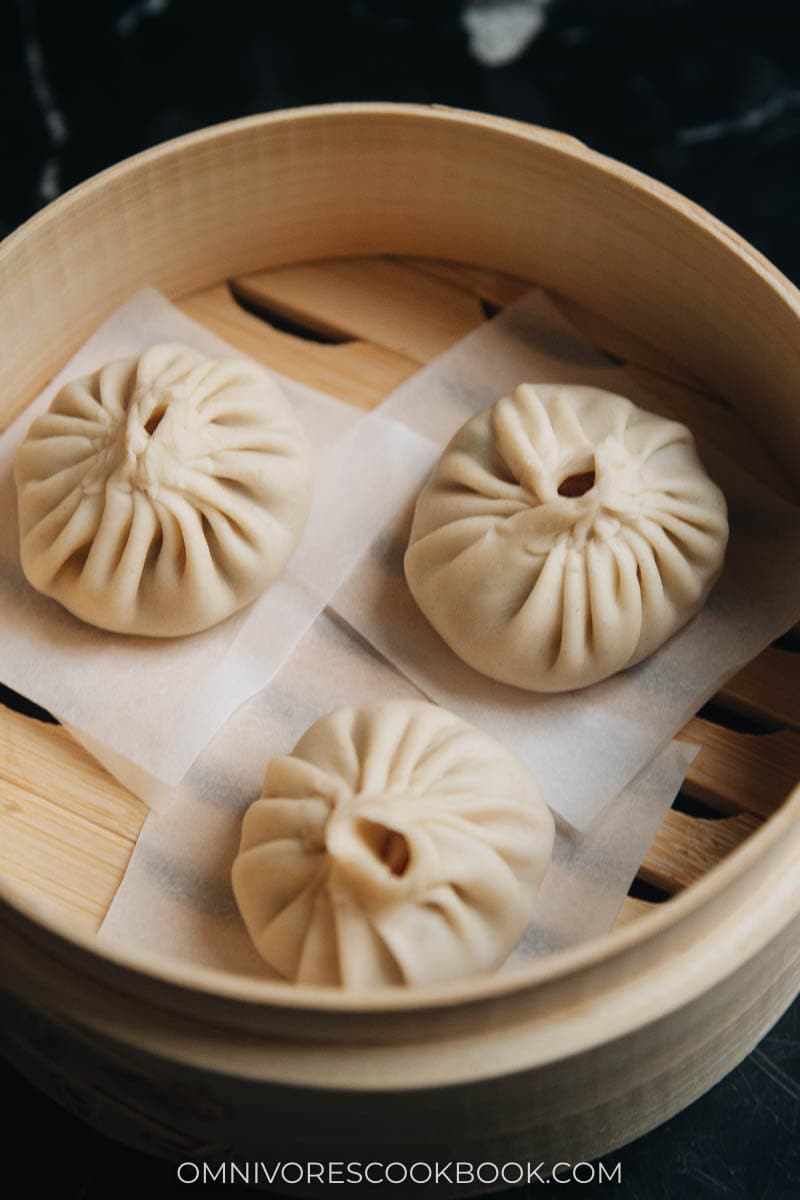
How to serve and store soup dumplings
Serving
Once you’ve made the soup dumplings, it’s important to to serve them immediately while they’re still hot. Because the longer you let the cooked dumplings sit, the more the dough will absorb the soup and your dumplings will end up less juicy.
Since the dumplings are juicy and delicious, you can totally eat them by themselves. To serve them the traditional way, you can cut some thin ginger strips and soak them in Chinkiang vinegar. It adds a tanginess to the dumplings and tastes very delicious.
To eat a soup dumpling, carefully lift it with your chopsticks onto a soup spoon. From there, you can:
- Poke a hole in the skin and let the soup run out. Then slurp the soup and eat the dumpling (with or without the dipping sauce).
- My favorite way is to slurp the soup directly from the dumpling, or eat the whole thing once it cools down a bit. Do NOT try this if your soup dumplings are still steaming hot. It might burn your tongue.
How to make ahead
If you plan to prepare soup dumplings in advance, you can make the dough and the filling in advance, and wrap and cook the dumplings when you’re ready and serve them immediately. The wrapped dumplings can sit covered in the fridge for up to an hour but I highly recommend cooking them as soon as possible. The longer the raw dumplings sit, the drier the outer layer of the dough will become and the soggier the inside will become.
Unfortunately, there’s no great way to store the wrapped dumplings in the freezer. I’ve tried it but all my dumplings ended up bursting open during the steaming process. The store-bought frozen soup dumplings use chemical additives to stabilize the filling – that’s why they can be frozen and still come out soupy. But chemical additives are not something that can be easily done at home.
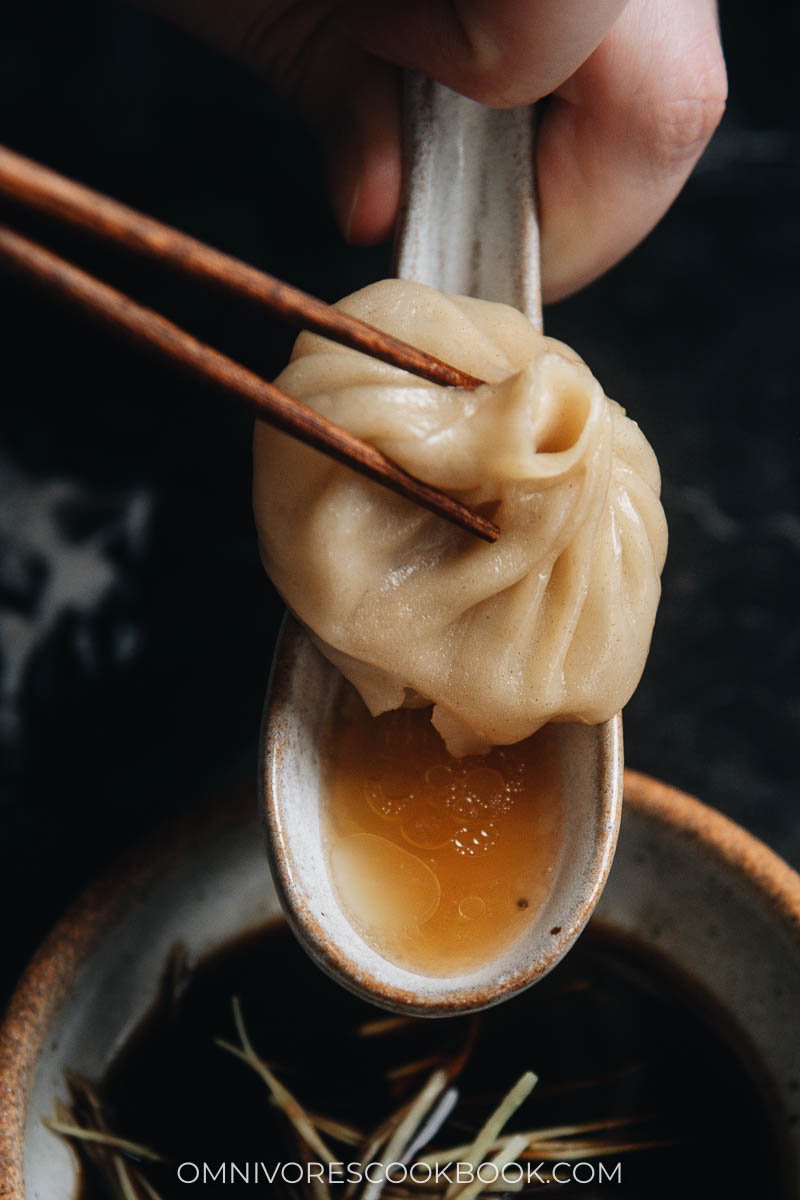
Afterthoughts
Making Xiao Long Bao at home definitely requires some time and effort. It’s one of those things that we would call a “restaurant dish” in China and would never make at home, since you can easily walk down the street and order a dozen of them for a fairly cheap price.
However, enjoying soup dumplings has become a luxury after coming to the US. While they’re readily available here in Manhattan’s Chinatown, they might be hard to come by where you live. It makes me appreciate this Shanghainese delicacy even more. And I hope this recipe will help you create some authentic tasting soup dumplings in your own kitchen.
This recipe requires precise measurements to make it work. I highly recommend using a scale to measure the ingredients for the wrappers instead of using volumetric measurements.
Chinese Cooking Made Easy
Are you new to this website? This free email series is a great place to start. I’ll walk you through a few of my most popular recipes and show you how and why they work. You’ll quickly start to cook better Chinese food in your own kitchen.
Watch video
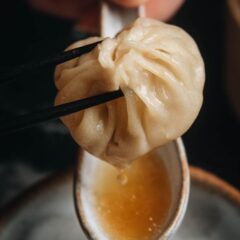
Homemade Soup Dumplings (Xiao Long Bao)
Ingredients
Jelly Broth
- 2.5 to 3 lbs chicken backs and necks
- 1 tablespoon vegetable oil
- 2 ” ginger , sliced
- 4 green onions , chopped into 3” (8 cm) pieces
Wrappers
- 120 g all purpose flour (2/3 cup plus 2 tablespoons)
- Pinch of salt
- 35 g hot water (2 tablespoons plus 1 teaspoon)
- 25 to 30 g cold water (about 2 tablespoons)
Filling
- 1 tablespoon grated ginger
- 8 oz fatty ground pork (*Footnote 1)
- 1 tablespoon light soy sauce
- 4 teaspoons Shaoxing wine (or dry sherry)
- 1/4 teaspoon salt
- 1/4 teaspoon sugar
- 1/8 teaspoon white pepper
- 4 green onions , finely minced
Dipping sauce
- Chinkiang vinegar
- ginger , very thinly sliced
Special tools
- Small Chinese rolling pin (*Footnote 2)
Instructions
Prepare the jelly (1 day ahead)
- Preheat the oven to 400°F (200°C).
- Prepare a medium-sized (about 4 qt) dutch oven with a lid or a roasting pan that can be securely sealed with a lid or foil. Add the oil to the pan and place it in the oven to heat up, 5 to 10 minutes.
- Once heated, carefully transfer the pan onto a trivet. Place the chicken back in the pan and spread the ginger and green onions on top of it. Add 1/4 cup water. Cover with the lid and return to the oven. Roast until you’ve collected a good amount of chicken broth in the bottom of the pot, 50 minutes or so.
- Remove the pan from the oven and let cool for 5 minutes. Use a pair of tongs to remove and discard the chicken backs.
- Lay a mesh strainer over a heat-proof bowl. Strain the chicken broth. Once cooled completely, transfer the chicken broth into a sealed container and refrigerate overnight.
Prepare the wrappers (the day you cook)
- Combine the flour and salt in a large bowl. Slowly drizzle the hot water over the flour while stirring with a pair of chopsticks (or a fork). Mix until the hot water is fully absorbed.
- Then slowly drizzle 25 g of cold water over the dry flour while mixing. Once the water is fully absorbed and the flour turns into dough flakes, start pressing with your hand to gather the dough together while mixing in as much dry flour as you can. If the dough is almost formed but there’s still dry flour left in the bowl, add the remaining 5 g water and keep kneading. Once done, it should form a semi-soft dough and no flour is left in the bowl.
- Transfer the dough onto a clean working surface and knead for 15 to 20 minutes, until the surface is smooth and the texture elastic. The dough should feel soft to the touch and not stick to your hands.
- Wrap the dough with plastic wrap and let it rest for 45 minutes.
- Storage: You can store the dough at this point if you decide to assemble the dumpling later. The dough can be stored in a sealed container in the fridge overnight.
Prepare the filling (the day you cook)
- Add the grated ginger into a small bowl and pour in 1/4 cup hot water. Let sit while preparing other ingredients.
- The chicken broth you made the day before should have become congealed with a layer of fat on top. Scrape off the fat and reserve it in a small bowl.
- Slice the chicken gelatin into thin strips, then further into small cubes. Coarsely mince it into bits.
- Measure the chopped gelatin. If it’s less than 4.4 oz (120 g), add a few spoonfuls of the chicken fat until it reaches 4.4 oz (120 g). You can discard or reserve the remaining chicken fat for future use. Store the gelatin in the fridge while not using.
- Add the ground pork into a medium-sized bowl. Add the ginger water, light soy sauce, Shaoxing wine, salt, sugar and white pepper. Beat with a spatula until the liquid is fully absorbed and the filling becomes sticky and bouncy, 5 minutes or so.
- Add the chopped chicken jelly and green onions. Mix until incorporated.
- Cover the bowl with plastic wrap and store in the fridge until ready to use. The filling can be stored in the fridge for a couple of hours, but I do not recommend storing it for too much longer, because the liquid will start to seep out.
Forming the buns
- Line a steamer rack with napa cabbage leaves or prepare some square parchment paper for steaming the dumplings.
- Place the rested dough onto a clean working surface. Roll it into a long log, about 1” (2.5 cm) in diameter. Cut the log in half, wrap one half with plastic wrap and place it in the fridge while working on the other half.
- Roll out the log a bit more. Divide it into two equal pieces, then further cut them into 10 pieces in total. Cover them with a few layers of wet paper towels to prevent drying out.
- Work on the buns one at a time. Shape one piece of dough with your fingers so it is a round piece, then flatten it with your palm. Use a small rolling pin to roll out the wrapper, spinning the dough after rolling a few times. Roll until the wrapper is very thin, about 4 1/2” (11 cm) in diameter. (*Footnote 3)
- Place 22 g (about 1 tablespoon) of the filling onto the center of the wrapper. Fold and pinch the edges of the wrapper to create pleats (see the wrapping process in action in my cooking video). When you are about to seal the pleats, leave a small opening on the top of the dumplings (very important – *Footnote 4).
- Place the wrapped dumplings onto the napa cabbage or parchment paper. Cover loosely with a few layers of wet paper towels to prevent drying out. Work on the rest of the dumplings until you can fill the steamer rack – you should leave at least 2” (5 cm) between the dumplings.
Cooking the dumplings
- Prepare the dipping sauce by adding 1 tablespoon of Chinese vinegar and a few strips of ginger to each small sauce plate.
- Bring a pot of water to a boil over medium-high heat. Cover the steamer rack with a lid and place it over the boiling water. Steam over medium-high heat for 8 to 10 minutes, depending on the number of dumplings you cook at a time.
- Once done cooking, serve immediately with the dipping sauce.
- To eat the soup dumplings, hold a pair of chopsticks in one hand and a big spoon in the other. Carefully use the chopsticks to pick up the soup dumpling and place it into the spoon. If you’re skillful with chopsticks, you can also dip the dumpling into the dipping sauce. Otherwise, drizzle a tiny amount of sauce over the dumpling. Have a small bite of the dumplings to let the steam out and allow the soup to pool in the spoon. If you don’t mind hot food (it’s very hot!), you can also let the soup stay in the dumpling and eat it all in one bite (I do not recommend this method if you’re not familiar with soup dumplings).
Notes
- I highly recommend using 30% fat ground pork for a tenderer and juicier result. Lean ground pork works as well but the meat will be a bit tougher once cooked.
- A small rolling pin is highly recommended to work on these small delicate wrappers.
- It’s important to roll the wrapper very thin, otherwise the dough will have a tough mouthfeel once cooked.
- The small opening on the dumpling will allow the steam to release as you cook it, to prevent the dumpling skin from bursting.
Nutrition

Did you make this recipe?
I’d love to hear how it turned out for you! Please take a moment to leave a 5-star rating ⭐️ and share your thoughts in the comments further down the page. It really helps others discover the recipe too.
Lilja Walter is a part of the Omnivore’s Cookbook team and worked closely with Maggie to develop and test this recipe.

Shannon
I made this over the course of a rainy weekend with a couple variables: my jelly didn’t set (I didn’t have/wasn’t able to find chicken necks so used skin-on, bone-in legs), so I mixed in a little miso broth and added some gelatin to solidify it – that seemed to work great. I also don’t have a bamboo steamer basket so used a stainless steel one with a parchment base and a dish towel below the lid to catch condensation. I did have the opening in the tops of my dumplings and felt like the dough looked great while rolling/filling, but unfortunately the wrappers fell apart at the bottom while steaming and lost the soup 🙁 I would guess this has to do with my steamer setup, but am not sure if there are other variables that I should consider?
Beyond that, it was fun to try a complex recipe and they were still delicious. My husband had no qualms with the lost soup and would easily be able to eat these faster than we can cook them 😀
Maggie Zhu
Hi Shannon, thanks for leaving such as thorough review! It’s definitely important to use chicken cuts that contains a lot of gelatins, such as chicken feet and neck. I do think it’s totally OK to use gelatin to solidify the soup, and that shouldn’t cause the leaking. For the wrapper, try to roll it thin but keep the center a litter thicker. You do want it to have some thickness to hold the soup in. The edges should be thinner so the dough doesn’t taste too thick after making the pleats. If the dough is rolled too thin, or if it absorbs too much moisture from condensation, it will tear easily. This is the most common cause.
Stainless steamers tend to collect more condensation, which can drip onto the dumplings and make the dough soggy. This weakens the wrapper and causes breakage. I do think the patted kitchen towels help with this, so it’s less likely the issue.
I’m glad to hear that you enjoyed the dumplings without the soup!
Tiffany
Have you tried storing them in the freezer with a vacuum seal bag like foodsavers?
Just curious as I would like to try this recipe but also love to make large batches of stuff for later as well!
Maggie Zhu
I think vacuum bags are tricky because the bags will press into the buns when you remove the air. The buns are quite delicate, so I think a large tray with air-tight lid works better.
That being said, it’s very tricky to freeze these soup dumplings. When I tested at home, the frozen ones always burst open after steaming. Maybe you will have a slightly better result if making the wrapper a little thicker, but then it changes the texture of the dumplings.
Nick G
Sounds fantastic. It’s the day after Thanksgiving, and while I usually make an aspic out of the turkey carcass, I’m going to try my had at Xiao Long Bao this year. I spatchcocked and smoked our turkey this year, so the stock is going to be quite rich. The carcass has simmered overnight as is now ready to be strained and reduced. I’ll be making the dumplings this weekend.
Ellen Ogdemli
Very tasty/ not over complicated recipe. I think maybe I rolled my dough too thin because my dumpling skins all broke, or perhaps too much broth? I made beef bone broth but maybe I should have reduced it.
Maggie Zhu
If using beef broth, you should make sure to use cuts that produce a lot of gelatin. For example, for the traditional pork broth, you usually will use pork trotters and pork skin. And it helps a lot if you reduce the broth. When the broth cools down in the fridge, it should be a block of gelatin and not in liquid form. The skin is quite delicate. I think ideally you should roll them out thin, but wrapping and the cooking do require skills and experience.
Thanks for sharing your cooking experience!
Cynthia Ladson
? Can I use wonton wrappers instead of making the dumplings
Maggie Zhu
Wonton wrappers won’t work because they are very thin and won’t seal well enough to hold all the soup from the filling.
If you do not want to make the dough, I would try to use dumplings wrappers. If using dumpling wrappers, I highly recommend you make the soup dumplings into the shape of regular dumplings (potstickers) like these: https://omnivorescookbook.com/pork-and-chive-dumplings/
Because storebought wrappers are quite stiff and you will have a hard time to make it into “xiao long bao” shape without making the top part of the dumplings super thick and chewy.
Alexus
I really want to make this for my friend when she visits but I can’t find chicken back or neck. What is another item I can use to make this? Plus I love soup dumplings and want to make my own so bad and this recipe looks amazing. Will using ground chicken work my friend doesn’t eat pork?
Maggie Zhu
It’s very challenging to find an alternative for the chicken back / neck if your friend doesn’t eat pork. Traditionally soup dumplings use pork bones (like trotters) to extract the gelatin for the soup part. I used chicken in this recipe because I like the taste and the ingredients are slightly easier to find. I guess you can use other cuts of chicken for this step, but you might need to use more bone-in chicken cuts and it’s kinda of a waste (the gelatin you want to extract comes from the bones and marrow). For the filling, ground chicken can work but it won’t be as tender as the pork because they are quite lean. I think you can still make the soup dumplings using all chicken but it would help a lot if you can manage to find chicken back or neck. If your local grocery stores do not have it, you can ask the store. Sometimes the stores do have them on the back and do not display them in the store.
Arlene
Awesome recipe! However, I had a ton of filling leftover after making 20 dumplings. I had prepared a second dough for just in case and ended up using it to make a total of 40 with the amount of filling I had but still had enough to make possibly 10 more. So in the future I’d probably make 3 doughs for the amount of filling suggested for this recipe.
Lee
How much jelly do you put in? In cups if you have that measurement available? Thank you!
Maggie Zhu
For the filling, I used all the chicken broth I gathered from the roasting. You won’t get much, maybe about 1/2 cup in total or less (I didn’t measure at the time, but it only fill the bottom of a small container). And once you mix it into the filling, each bun will get about the same amount of jelly.
Anna
Hi there! I’ve always struggled to roll out individual dumpling wrappers. I was wondering if you thought it would work if I rolled out a large piece of dough and then cut out wrappers with a circle cutter?
Maggie Zhu
You can certainly make the wrappers this way. My suggestion is, make sure the sheet is not too big, so you can work on a few dumplings at a time before rolling out more dough. This is to prevent the wrapper from drying out, since they are very thin once it’s rolled out and will lose moisture very fast.
S. Knowles
This is a labor of love but extremely worth the effort. Big pay off!
Maggie Zhu
So happy to hear you tried out this recipe and enjoyed it! And thanks for leaving a positive review 🙂
Lee Chu
Thank you for sharing your recipes. I cannot always purchase the necessary ingredients, but I do appreciate when you suggest optional ingredients to replace hard to get ones. Please stay safe.
Channon Doughty
This recipe is divine! I’m so glad I’ll be able to have soup dumplings when we move to Maine!
Nic North
FYI, Sichuan Kitchen in Portland has excellent soup dumplings on their menu now. Maine is rural but we are a surprisingly foodie place 😉
Channon Doughty
Thank you so much for the advice you gave in your “A Message about Chinatown + Homemade Soup Dumplings” update today. I am in LA, but moving away soon, so I’ve been wanting to visit some of my favorite Asian shops and restaurants before I go, but I was afraid I would not be welcome, due to pandemic risk and to the ignorance of so many people lashing out at Asians over the pandemic. I am happy to know that my business would be a good thing and now I know I have to go!